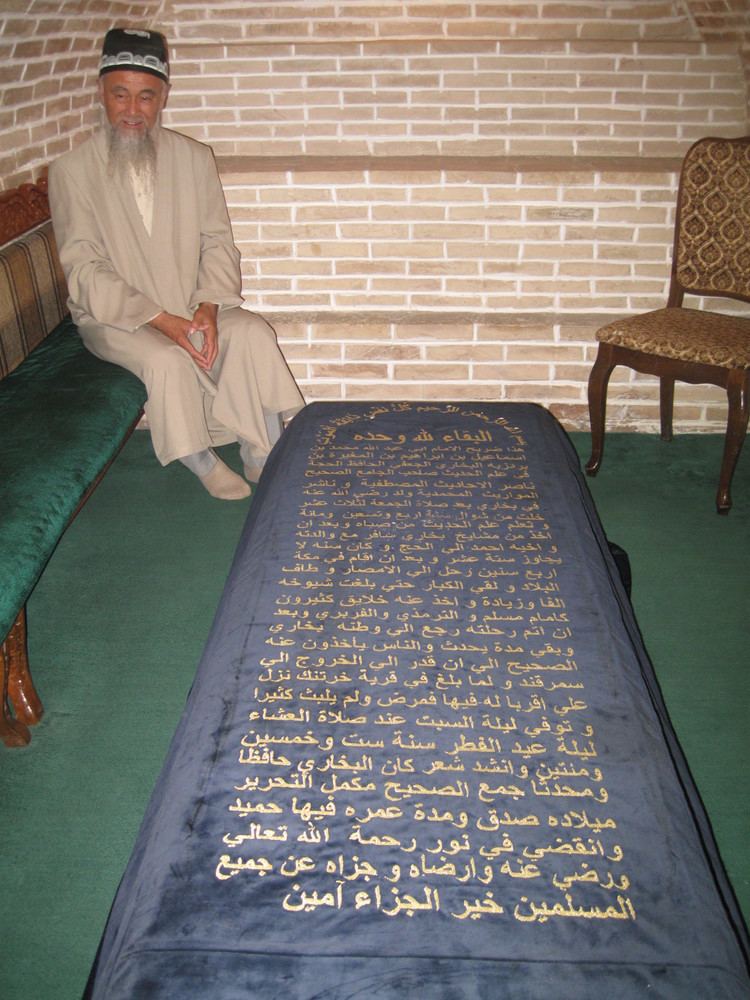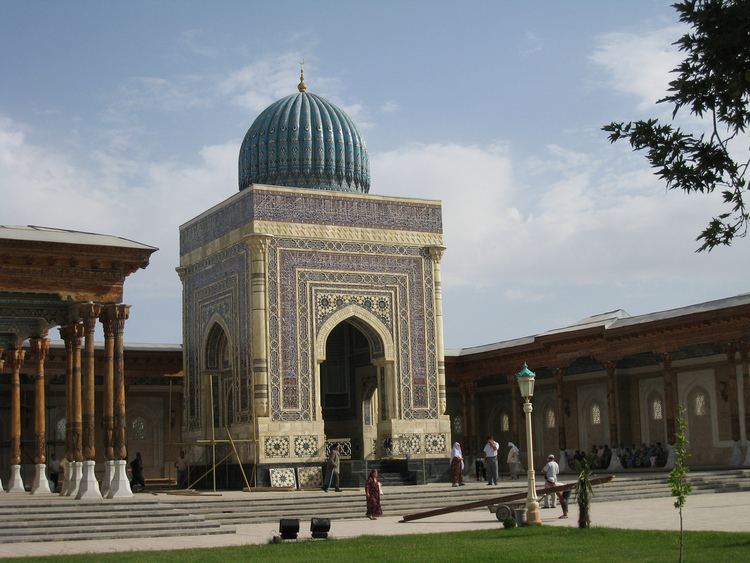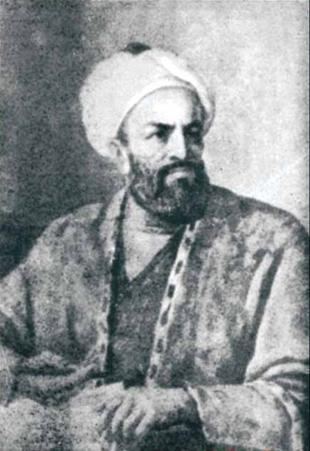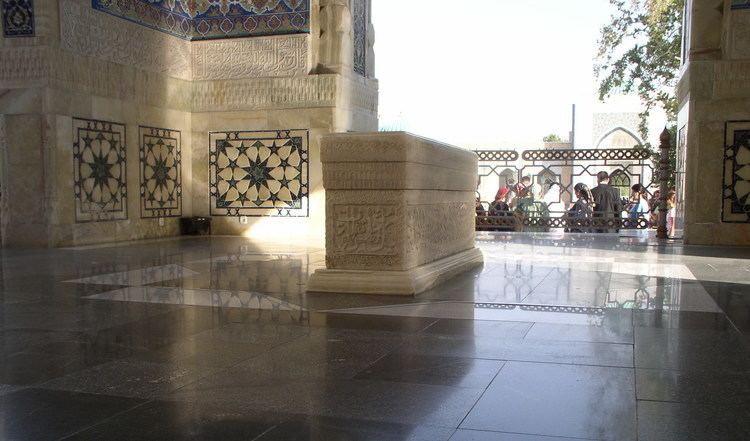Role Islamic scholar Name Muhammad al-Bukhari | Religion Islam Parents Ismail ibn Ibrahim | |
Occupation Muhaddith, Hadith compiler, Islamic scholar Full name Abu ‘Abd Allah Muhammad ibn Isma‘il ibn Ibrahim ibn al-Mughirah ibn Bardizbah al-Ju‘fi al-Bukhari Buried Muhammad al-Bukhari Mausoleum Books Sahih al-Bukhari, The Great History Similar People Muhammad ibn Isa at‑Tirmidhi, Muslim ibn al‑Hajjaj, Ahmad ibn Hanbal, Ibn Taymiyyah, Al‑Shafi‘i | ||
Abū ‘Abd Allāh Muḥammad ibn Ismā‘īl ibn Ibrāhīm ibn al-Mughīrah ibn Bardizbah al-Ju‘fī al-Bukhārī (Arabic: أبو عبد الله محمد بن اسماعيل بن ابراهيم بن المغيرة بن بردزبه الجعفي البخاري; 19 July 810 – 1 September 870), or Bukhārī (Persian: بخاری), commonly referred to as Imam al-Bukhari or Imam Bukhari, was a Persian Islamic scholar who was born in Bukhara (the capital of the Bukhara Region (viloyat) of Uzbekistan). He authored the hadith collection known as Sahih al-Bukhari, regarded by Sunni Muslims as one of the most authentic (sahih) hadith collections. He also wrote other books such as Al-Adab al-Mufrad.
Contents
- Birth
- Facts
- Lineage
- Hadith studies and travels
- Last years
- Writings
- Works describing narrators of hadith
- Hadith works
- School of thought
- References

Birth

Muhammad ibn Isma`il al-Bukhari al-Ju`fi was born after the Jumu'ah prayer on Friday, 19 July 810 (13 Shawwal 194 AH) in the city of Bukhara in Transoxiana (in present-day Uzbekistan).

His father, Ismail ibn Ibrahim, a scholar of hadith, was a student and associate of Malik ibn Anas. Some Iraqi scholars related hadith narrations from him.
Facts
Lineage

Imam Bukhari's great-grandfather, al-Mughirah, settled in Bukhara after accepting Islam at the hands of Bukhara's governor, Yaman al-Ju`fi. As was the custom, he became a mawla of Yaman, and his family continued to carry the nisbah of "al-Ju`fi".

Al-Mughirah's father, Bardizbah, is the earliest known ancestor of Bukhari according to most scholars and historians. He was a Zoroastrian Magi, and died as such. As-Subki is the only scholar to name Bardizbah's father, who he says was named Bazzabah (Persian: بذذبه). Little is known of either Bardizbah or Bazzabah, except that they were Persian and followed the religion of their people. Historians have also not come across any information on Bukhari's grandfather, Ibrahim ibn al-Mughirah.
Hadith studies and travels

The historian al-Dhahabi described his early academic life:
He began studying hadith in the year 205 (A.H.). He memorized the works of [‘Abdullah] ibn al-Mubaarak while still a child. He was raised by his mother because his father died when he was an infant. He traveled with his mother and brother in the year 210 after having heard the narrations of his region. He began authoring books and narrating hadith while still an adolescent. He said, “When I turned eighteen years old, I began writing about the Companions and the Followers and their statements. This was during the time of ‘Ubaid Allah ibn Musa (one of his teachers). At that time I also authored a book of history at the grave of the Prophet at night during a full moon.
At the age of sixteen, he, together with his brother and widowed mother, made the pilgrimage to Mecca. From there he made a series of travels in order to increase his knowledge of hadith. He went through all the important centres of Islamic learning of his time, talked to scholars and exchanged information on hadith. It is said that he heard from over 1,000 men, and learned over 600,000 traditions.
After sixteen years absence, he returned to Bukhara, and there he drew up his al-Jami' as-Sahih, a collection of 7,275 tested traditions, arranged in chapters so as to afford a basis for a complete system of jurisprudence without the use of speculative law.
His book is highly regarded among Sunni Muslims, and considered the most authentic collection of hadith, even ahead of the Muwatta Imam Malik and Sahih Muslim of Bukhari's student Muslim ibn al-Hajjaj. Most Sunni scholars consider it second only to the Quran in terms of authenticity. He also composed other books, including al-Adab al-Mufrad, which is a collection of hadiths on ethics and manners, as well as two books containing biographies of hadith narrators (see isnad).
Last years
In the year 864/250, he settled in Nishapur. It was in Nishapur that he met Muslim ibn al-Hajjaj. He would be considered his student, and eventually collector and organiser of hadith collection Sahih Muslim which is considered second only to that of al-Bukhari. Political problems led him to move to Khartank, a village near Samarkand where he died in the year 870/256.
Writings
Below is a summary of the discussion of Bukhari's available works in Fihrist Muṣannafāt al-Bukhāri by Umm 'Abdullāh bint Maḥrūs, Muḥammad ibn Ḥamza and Maḥmūd ibn Muḥammad.
Works describing narrators of hadith
Bukhari wrote three works discussing narrators of hadith with respect to their ability in conveying their material: the "brief compendium of hadith narrators," "the medium compendium" and the "large compendium" (al-Tarikh al-Kabīr, al-Tarīkh al-Ṣaghīr, and al-Tarīkh al-Awsaţ). The large compendium is published and well-identified. The medium compendium was thought to be the brief collection and was published as such. The brief compendium has yet to be found. Another work, al-Kunā, is on patronymics: identifying people who are commonly known as "Father of so-and-so". Then there is a brief work on weak narrators: al-Ḍu'afā al-Ṣaghīr.
Hadith works
Two of Bukhari's hadith works have survived: al-Adab al-mufrad ("the book devoted to matters of respect and propriety") and al-Jāmi’ al-Musnad al-Sahīh al-Mukhtaṣar min umūr Rasûl Allāh wa sunnanihi wa ayyāmihi (The abridged collection of sound reports with chains of narration going back all the way to the Prophet regarding matters pertaining to the Prophet, his practices and his times.) – also known as Sahih al-Bukhari.
School of thought
Bukhari has been claimed as a follower of the Hanbali school of thought within Islamic jurisprudence, although members of the Shafi'i and Ẓāhirī schools levy this claim as well.
Historical evidence suggests that Bukhari's legal positions were similar to those of the Zahiris and Hanbalis of his time, given the fact that Bukhari rejected qiyas and other forms of ra'y completely. Bukhari's positions have even been compared to those of Ibn Hazm.
Al-Dhahabi said that Imam Bukhari was a mujtahid, a scholar capable of making his own ijtihad without following any Islamic school of jurisprudence in particular.
